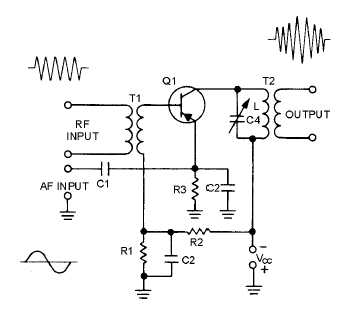1-62
extremely low-level modulator that is useful in portable equipment. In emitter-injection modulation, the
gain of the rf amplifier is varied by the changing voltage on the emitter. The changing voltage is caused
by the injection of the modulating signal into the emitter circuitry of Q1, as shown in figure 1-51. Here
the modulating voltage adds to or subtracts from transistor biasing. The change in bias causes a change in
collector current and results in a heterodyning action. The modulation envelope is developed across the
collector-tank circuit.
Figure 1-51.—Emitter-injection modulator.
Q-44. When is a control-grid modulator used?
Q-45. What type of modulator is the cathode modulator (low- or high-level)?
Q-46. What causes the change in collector current in an emitter-injection modulator?
You have studied six methods of amplitude modulation. These are not the only methods available,
but they are the most common. All methods of AM modulation use the same theory of heterodyning
across a nonlinear device. AM modulation is one of the easiest and least expensive types of modulation to
achieve. The primary disadvantages of AM modulation are susceptibility to noise interference and the
inefficiency of the transmitter. Power is wasted in the transmission of the carrier frequency because it
contains no AM intelligence. In the next chapter, you will study other forms of modulation that have been
developed to overcome these disadvantages.
SUMMARY
Now that you have completed this chapter, a short review of what you have learned is in order. The
following summary will refresh your memory of amplitude modulation, its basic principles, and typical
circuitry used to generate this modulation.
The SINE WAVE is the basis for all complex waveforms and is generated by moving a coil through
a magnetic field.

